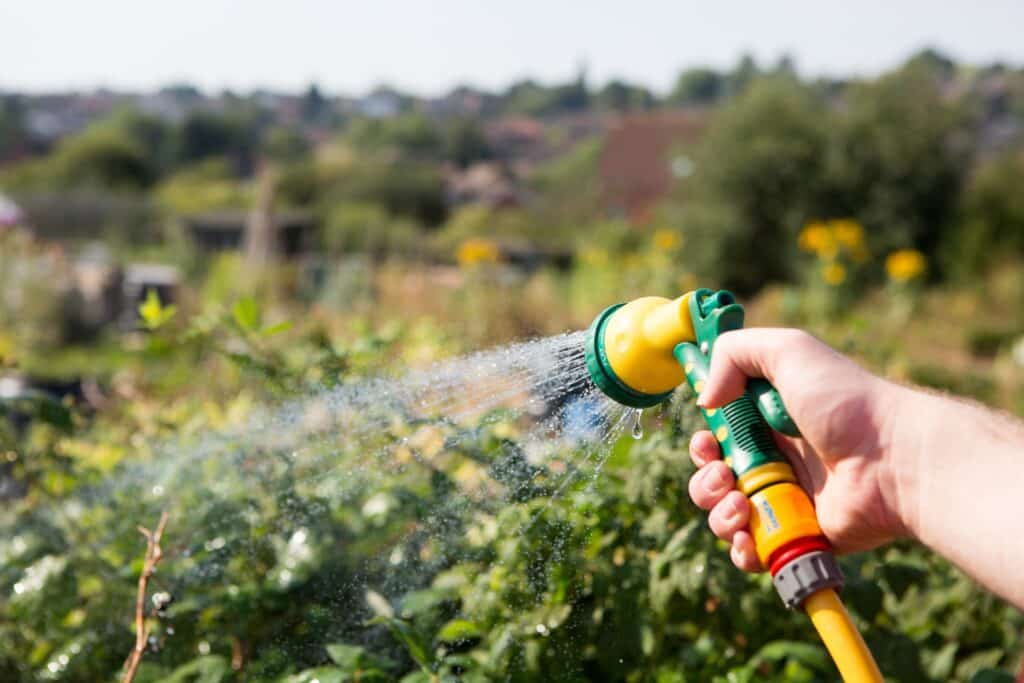
Summer care for hedges – How to Trim Hedges and other Tips
Summer care for hedges
Summer is a crucial time for hedge care. As the weather warms up, your hedges will start to grow more rapidly, and it’s essential to keep them in check. One question many gardeners ask is, “Can I trim my hedges now?” The answer is yes, especially for evergreens. Trimming hedges in summer helps to maintain their shape and promotes healthy growth.
Here are some key ways to maintain your hedges during the summer:
- Regular Trimming: Regular trimming is essential to keep your hedges in shape and to promote denser growth. It’s best to trim little and often, rather than cutting back a lot of growth at once. This will help to prevent the hedge from becoming too ‘woody’ and sparse.
- Watering: During the summer months, your hedges may need more water, especially in dry spells. Water deeply and less frequently to encourage the roots to grow deeper into the soil, which will make your hedges more drought-resistant.
- Feeding: Apply a slow-release fertiliser in early summer to provide your hedges with the nutrients they need to grow strong and healthy. A well-fed hedge is more likely to be dense and vibrant.
- Mulching: Mulching around the base of your hedges can help to conserve moisture, suppress weeds and improve soil quality. Organic mulches, such as compost or well-rotted manure, can also provide additional nutrients.
- Pest and Disease Control: Keep an eye out for signs of pests or diseases, such as discoloured leaves or unusual growths. Early detection and treatment can prevent these problems from spreading and causing more damage.
- Pruning: Pruning involves removing dead or diseased branches to allow more light and air to reach the inner parts of the hedge. It’s best to prune your hedges on a cool, cloudy day to prevent the cut leaves from getting sunburnt.
Remember, the key to maintaining healthy hedges is regular care and attention. By following these steps, you can ensure that your hedges stay healthy and look great throughout the summer.

Why is it Important to Cut Your Hedge in Summer?
Hedge cutting is not just about aesthetics. It’s also about the health of your hedges. Regular trimming prevents hedges from becoming overgrown, which can lead to problems with pests and diseases. It also encourages denser growth, making your hedges look fuller and more attractive.
Here are some key reasons why hedge-cutting is particularly important in the summer:
- Promotes Healthy Growth: Regular hedge cutting in the summer encourages new growth and helps to maintain the health and vitality of your hedges. It ensures that light and air can reach all parts of the hedge, which is essential for photosynthesis and overall plant health.
- Controls Pests and Diseases: Overgrown hedges can become a breeding ground for pests and diseases. Regular trimming in the summer helps to keep these issues in check. It allows you to spot any early signs of infestation or disease and take action before they can cause significant damage.
- Maintains Shape and Density: Summer is the main growing season for many types of hedges. Regular cutting during this time helps to maintain the shape of your hedges and promotes denser growth. This results in a fuller, more attractive hedge.
- Prevents Damage: Overgrown hedges can become heavy and may risk damage in high winds or storms. Regular trimming helps to keep the hedge manageable and reduces the risk of branches breaking off.
- Enhances Flowering: For hedges that produce flowers, regular trimming can stimulate the production of flower buds. This means you could enjoy a more vibrant and colourful display the following year.
Remember, while summer hedge cutting is beneficial, it’s essential to avoid cutting during the bird nesting season (usually March to August in the UK) to avoid disturbing nesting birds. Always check your hedges for nests before you start cutting.
Prune Your Hedges for Optimal Health
Pruning is another essential aspect of summer hedge care. This involves removing dead or diseased branches to allow more light and air to reach the inner parts of the hedge. It’s best to prune your hedges on a cool, cloudy day to prevent the cut leaves from getting sunburnt.
Here are some key reasons why pruning your hedges is crucial for their optimal health:
- Promotes Healthy Growth: Pruning encourages new growth by allowing more light and air to reach the inner parts of the hedge. This can lead to a denser, healthier hedge with more vibrant foliage.
- Controls Pests and Diseases: By removing dead or diseased branches, you can help prevent the spread of pests and diseases that could harm your hedge. Pruning also allows you to spot any early signs of trouble, so you can take action before it’s too late.
- Improves Appearance: Pruning helps to maintain the shape and structure of your hedges, leading to a more attractive appearance. It can also stimulate flowering in certain types of hedges, leading to a more colourful display.
- Boosts Longevity: Regular pruning can help to prolong the life of your hedges by maintaining their health and vitality. A well-pruned hedge is more likely to withstand the challenges of pests, diseases, and harsh weather.
- Encourages Fruit and Flower Production: For hedges that produce flowers or berries, pruning can stimulate the production of flower buds and fruit. This not only enhances the appearance of your hedge but can also provide food for local wildlife.
Remember, while pruning is beneficial, it’s important to do it correctly to avoid causing unnecessary stress to the hedge. Always use sharp, clean tools and make your cuts at a slight angle to allow water to run off.
Feeding and Watering Your Hedges
Just like any other plant, hedges need proper nutrition and hydration to thrive. During the summer months, it’s especially important to water your hedges regularly, as they can quickly dry out in the heat.
Feeding your hedges is also crucial. A slow-release fertiliser applied in early summer can provide your hedges with the nutrients they need to grow strong and healthy. Remember, a well-fed hedge is a happy hedge!

Here are some key tips for feeding and watering your hedges in summer:
- Water Deeply and Infrequently: Instead of watering a little every day, it’s better to water your hedges deeply and less frequently. This encourages the roots to grow deeper into the soil, making your hedges more resilient in dry conditions.
- Use Mulch to Retain Moisture: Applying a layer of organic mulch around the base of your hedges can help to conserve moisture in the soil. This is particularly beneficial during hot, dry periods.
- Feed with a Balanced Fertiliser: Hedges benefit from a balanced, slow-release fertiliser applied in early summer. This provides a steady supply of nutrients over several weeks, supporting healthy growth.
- Don’t Overfeed: While it’s important to feed your hedges, overdoing it can cause more harm than good. Excess fertiliser can lead to rapid, weak growth and increase susceptibility to pests and diseases.
- Water in the Morning or Evening: To reduce water loss through evaporation, it’s best to water your hedges in the early morning or late evening when temperatures are cooler.
- Check Soil Moisture Levels: Before watering, check the moisture level of the soil. If it’s still damp from the last watering, you can wait a little longer. Overwatering can be just as harmful as underwatering.
By following these tips, you can ensure that your hedges receive the hydration and nutrition they need to thrive during the summer months.
Planning for Autumn Hedge Planting
Summer is also the perfect time to start planning any new hedging or screening you might want to add to your garden. With everything in leaf, you can get a good idea of how different plants will look and where they might fit in your garden layout.
Remember, autumn is an excellent time for planting hedges. The soil is still warm from the summer, which helps the roots establish before winter. So, if you’re asking, “Can you trim hedges in September?” the answer is yes, and it’s also a great time to plant new ones!
Here are some key tips for planning your autumn hedge planting:
- Consider Your Space: Look at the space you have available and consider the size and shape of the hedges you want to plant. Remember, hedges can grow quite large, so make sure you have enough space for them to grow without becoming overcrowded.
- Choose the Right Plants: Not all plants are suitable for hedging. Consider the growing conditions in your garden (such as soil type and sunlight levels) and choose plants that will thrive in those conditions.
- Plan for Diversity: Consider planting a mix of different species to create a more diverse and attractive hedge. This can also benefit local wildlife by providing a range of food and habitat options.
- Prepare the Soil: Before planting, prepare the soil by removing any weeds and adding organic matter, such as compost or well-rotted manure. This will improve soil fertility and help your new hedges to establish more quickly.
- Think About Maintenance: Some hedges require more maintenance than others. Consider how much time you’re willing to spend on hedge maintenance and choose your plants accordingly.
- Plan for the Future: Remember, hedges are a long-term investment. Consider how your hedges will look in five or ten years’ time and plan accordingly.
By planning your hedge planting in the summer, you can ensure that you’re ready to go when autumn arrives, giving your new hedges the best possible start.
Frequently Asked Questions About Hedge Care
Should you trim hedges in summer?
Yes, summer is an excellent time to trim most types of hedges, especially evergreens. Regular trimming helps to maintain the shape of your hedges and promotes denser, healthier growth.
How do I keep my hedges healthy?
Keeping your hedges healthy involves regular trimming, proper feeding, and watering. It’s also important to check your hedges for signs of pests or diseases and to treat any problems as soon as they arise.
What month is best to trim hedges?
The best month to trim hedges depends on the type of hedge. Evergreen hedges can be trimmed in early to mid-summer, while deciduous hedges are best pruned in late summer.
When should you not trim hedges?
You should avoid trimming hedges in late autumn and winter when many plants are dormant. Also, avoid trimming during nesting season (usually March to August in the UK) to avoid disturbing nesting birds.
